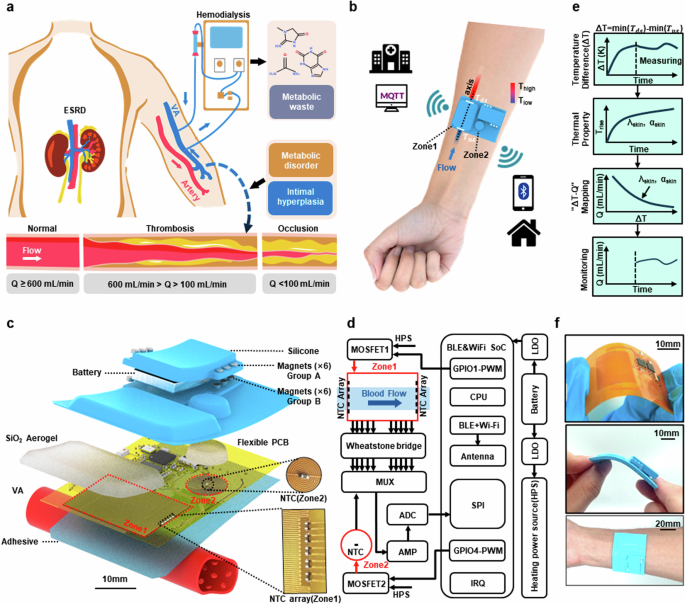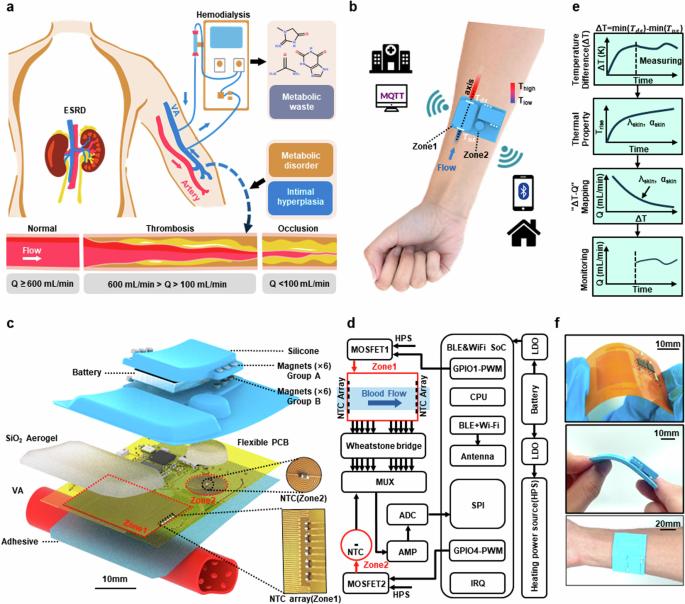用于血液透析患者高通量血管通路监测的自适应表皮血流传感器
IF 15.5
1区 材料科学
Q1 ENGINEERING, ELECTRICAL & ELECTRONIC
引用次数: 0
摘要
功能良好的血管通路(VA)对于终末期肾病(ESRD)患者的血液透析治疗至关重要。然而,无论是临床仪器还是可穿戴传感器,都无法在住院期间或在家中对血流量进行连续、准确的监测,以评估高通量血管通路。在此,我们报告了一种高精度、长期、表皮血流传感器的设计和临床前验证,该传感器可自行适应皮肤上不可避免的传感器安装偏差,并与个体组织差异兼容。具体来说,该技术以皮肤的热耗散为基础,在测量高流量血液(100-600 毫升/分钟)时,可将信噪比提高 4 倍以上。在临床前验证中,该传感器与多普勒超声进行了比较,结果显示血流分辨率为 10-50 毫升/分钟。此外,该传感器高度集成,可佩戴,尺寸为 36 × 50 平方毫米。该传感器为准确、方便、高流量的血液监测铺平了道路,为延长 ESRD 患者的生命提供了巨大的潜力。本文章由计算机程序翻译,如有差异,请以英文原文为准。


Self-adaptive epidermal blood flow sensor for high-flux vascular access monitoring of hemodialysis patients
Well-functioning vascular access (VA) is essential for hemodialysis treatment in patients with end-stage renal disease (ESRD). However, continuous and accurate monitoring of blood flow to assess high-flux VA during hospitalization or at home is not feasible for either clinical instruments or wearable sensors. Here, we report the design and preclinical validation of a high-precision, long-term, epidermal blood flow sensor that self-adapts to unavoidable sensor-mounting deviations on the skin and is compatible with individual tissue differences. Specifically, the technology is based on thermal dissipation of the skin, and improves the signal-to-error ratio surpassing 4 times when measuring high-flux blood (100–600 mL/min). In preclinical validation, the sensor is compared with the Doppler ultrasound and demonstrate a blood flow resolution of 10–50 mL/min. Furthermore, it is highly-integrated and wearable, measuring 36 × 50 mm2. The sensor paves the way for accurate, convenient, high-flux blood monitoring, offering significant potential to extend the lives of patients with ESRD.
求助全文
通过发布文献求助,成功后即可免费获取论文全文。
去求助
来源期刊

npj Flexible Electronics
Multiple-
CiteScore
17.10
自引率
4.80%
发文量
91
审稿时长
6 weeks
期刊介绍:
npj Flexible Electronics is an online-only and open access journal, which publishes high-quality papers related to flexible electronic systems, including plastic electronics and emerging materials, new device design and fabrication technologies, and applications.
 求助内容:
求助内容: 应助结果提醒方式:
应助结果提醒方式:


